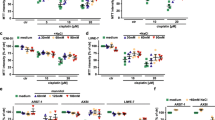Abstract
Background
Human skin or mucosa exposes cells to both an internal and exogeneous thermal environment and the cells survive within a certain range of temperature. Exogeneous hyperthermia has been applied for the treatment of various types of cancers, fungal disease, and warts.
Objectives
To determine whether different cellular components in the skin adapt to hyperthermic conditions differentially and further elucidate the mechanisms involved.
Materials & methods
Cell lines derived from normal and tumour epithelial cells were treated with hyperthermic conditions and tested for viability (using an MTS assay), apoptosis (using a FITC-conjugated annexin V apoptosis detection kit), and changes in intracellular calcium (using a calcium-sensitive fluorescent singlewavelength dye, Fluo-4 AM).
Results
Thermo-resistance of different cell types was different when cells were subjected to heat at 45◦C for 30 minutes. Stronger effects of hyperthermia were noted on cell viability and apoptosis in epidermal cells relative to their malignant counterparts, except for cell lines harbouring human papillomavirus (HPV). Hyperthermia had a much greater effect on cell viability and apoptosis in a HPV-negative cell line compared to HPV-positive cell lines. We further found that hyperthermia treatment resulted in a strong calcium influx which led to apoptotic cells. However, no obvious increase in apoptosis was observed in cells treated with the CRAC channel selective inhibitor, BTP2, before application of hyperthermia in all cell types, except three cervical cell lines harbouring HPV.
Conclusion
We propose that hyperthermia results in a CRAC-related strong calcium influx which induces apoptosis, with the exception of HPV-positive cells.
Similar content being viewed by others
References
Hegyi G, Szigeti GP, Szasz A. Hyperthermia versus oncothermia: cellular effects in complementary cancer therapy. Evid Based Complement Alternat Med 2013; 2013: 672873.
Datta NR, Rogers S, Klingbiel D, et al. Hyperthermia and radiotherapy with or without chemotherapy in locally advanced cervical cancer: a systematic review with conventional and network meta–analyses. Int J Hyperthermia 2016; 32: 809–21.
Soria F, Allasia M, Oderda M, Gontero P. Hyperthermia for non–muscle invasive bladder cancer. Expert Rev Anticancer Ther 2016; 16: 313–21.
Gao S, Zheng M, Ren X, Tang Y, Liang X. Local hyperthermia in head and neck cancer: mechanism, application and advance. Oncotarget 2016; 7: 57367–78.
Wang HX, Yang Y, Guo H, et al. HSPB1 deficiency sensitizes melanoma cells to hyperthermia induced cell death. Oncotarget 2016; 7: 67449–62.
Takahashi S, Masahashi T, Maie O. Local thermotherapy in sporotrichosis. Hautarzt 1982; 32: 525–8.
Gao XH, Gao D, Sun XP, et al. Non–ablative controlled local hyperthermia for common warts. Chin Med J (Engl) 2009; 122: 2061–3.
Huo W, Gao XH, Sun XP, et al. Local hyperthermia at 44 degrees C for the treatment of plantar warts: a randomized, patient–blinded, placebo–controlled trial. J Infect Dis 2010; 201: 1169–72.
Mouratidis PX, Rivens I, Ter Haar G. A study of thermal doseinduced autophagy, apoptosis and necroptosis in colon cancer cells. Int J Hyperthermia 2015; 31: 476–88.
Vig M, Kinet JP. Calcium signaling in immune cells. Nat Immunol 2009; 10: 21–7.
Cahalan MD. STIMulating store–operated Ca(2+) entry. Nat Cell Biol 2009; 11: 669–77.
Xiao B, Coste B, Mathur J, Patapoutian A. Temperature–dependent STIM1 activation induces Ca(2)+ influx and modulates gene expression. Nat Chem Biol 2011; 7: 351–8.
Mancarella S, Wang Y, Gill DL. Signal transduction: STIM1 senses both Ca(2)+ and heat. Nat Chem Biol 2011; 7: 344–5.
Umemura M, Baljinnyam E, Feske S, et al. Store–operated Ca2+ entry (SOCE) regulates melanoma proliferation and cell migration. PLoS One 2014; 9: e89292.
Chen YF, Chiu WT, Chen YT, et al. Calcium store sensor stromalinteraction molecule 1–dependent signaling plays an important role in cervical cancer growth, migration, and angiogenesis. Proc Natl Acad Sci USA 2011; 108: 15225–30.
Green DR, Reed JC. Mitochondria and apoptosis. Science 1998; 281: 1309–12.
Honda H, Kondo T, Zhao QL, Feril LB Jr., Kitagawa H. Role of intracellular calcium ions and reactive oxygen species in apoptosis induced by ultrasound. Ultrasound Med Biol 2004; 30: 683–92.
Fajardo LF, Egbert B, Marmor J, Hahn GM. Effects of hyperthermia in a malignant tumor. Cancer 1980; 45: 613–23.
Tamm I, Wang Y, Sausville E, et al. IAP–family protein survivin inhibits caspase activity and apoptosis induced by Fas (CD95), Bax, caspases, and anticancer drugs. Cancer Res 1998; 58: 5315–20.
Branca M, Giorgi C, Santini D, et al. Survivin as a marker of cervical intraepithelial neoplasia and high–risk human papillomavirus and a predictor of virus clearance and prognosis in cervical cancer. Am J Clin Pathol 2005; 124: 113–21.
Frost M, Jarboe EA, Orlicky D, et al. Immunohistochemical localization of survivin in benign cervical mucosa, cervical dysplasia, and invasive squamous cell carcinoma. Am J Clin Pathol 2002; 117: 738–44.
Honegger A, Leitz J, Bulkescher J, Hoppe–Seyler K, Hoppe–Seyler F. Silencing of human papillomavirus (HPV) E6/E7 oncogene expression affects both the contents and the amounts of extracellular microvesicles released from HPV–positive cancer cells. Int J Cancer 2013; 133: 1631–42.
Borbely AA, Murvai M, Konya J, et al. Effects of human papillomavirus type 16 oncoproteins on survivin gene expression. J Gen Virol 2006; 87: 287–94.
Saxena A, Yashar C, Taylor DD, Gercel–Taylor C. Cellular response to chemotherapy and radiation in cervical cancer. Am J Obstet Gynecol 2005; 192: 1399–403.
Milrot E, Jackman A, Kniazhanski T, et al. Methyl jasmonate reduces the survival of cervical cancer cells and downregulates HPV E6 and E7, and survivin. Cancer Lett 2012; 319: 31–8.
Author information
Authors and Affiliations
Corresponding author
About this article
Cite this article
Li, ZX., Wang, HX., Yang, Y. et al. Susceptibility of epithelial tumour cell lines to hyperthermia. Eur J Dermatol 28, 606–612 (2018). https://doi.org/10.1684/ejd.2018.3417
Accepted:
Published:
Issue Date:
DOI: https://doi.org/10.1684/ejd.2018.3417




